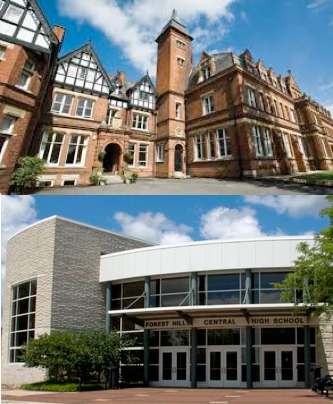British boarding school vs. American high school

Before moving to Michigan two months ago, I spent the last one and a half years living in a small city called Cheltenham in England. While there, I attended Dean Close day-boarding school, and it was an incredible experience. For those 18 months, I was absorbed in English culture and became a part of my English school.
My family lived only ten minutes away from school. Because of the short commute, I joined the 30% of the school who came to school every day instead of boarding. We were called “day-studentsa��, and had mostly the same experience as the boarders, except that we returned home at the end of the day.
I’ve only been at FHC for two months, but there are so many everyday differences that I’ve adjusted to. I’ve already been asked several times about what life at an English school was like. These are the top 10 differences between British boarding school and American high school:
- Uniform – In England, school uniform has never been up for debate, as it has always been custom. Almost every school there has a school uniform that every student wears. My uniform consisted of a plaid pleated skirt and a sweater with the school crest embroidered onto it. Although at first, I disliked the lack of freedom, I soon became grateful for the uniform. It cut out the decisions of choosing clothes, as well as gave everyone a sense of community.
- Houses – Just like in Harry Potter and other British stories, each student at school belonged to a house. There were nicknames for every house, such as “the sporty housea�� or “the smart housea��. However, I soon realized that those names were fabricated, as each house had a completely different mix of people. Each person contributed something different to their house and your house truly became your family. Each day-student also had a study in their house, which was a small room that you shared with a friend for the school year to spend time and keep belongings in.
- Sport – Every student was required to play a sport during all three terms (trimesters). I did not appreciate this at first, but soon came to love what the British called “gamesa��. The boys played rugby, field hockey, and cricket. The girls played field hockey, netball (a variation of basketball), and tennis. Every student played a sport for six hours a week, and most were placed on teams that played against other schools in the area.
- Hours & days – Hours at school were very long, with most weeks requiring more than 50 hours. Lessons ran from 8 am to 4 pm every day, but compulsory activities such as sport, cadet programs, and extracurriculars kept students at school until 6 pm everyday. School also ran on Saturdays until noon, followed by sports matches. Although the hours seemed terrible at first, I soon realized they gave you a lot of downtime to socialize as well as complete homework.
- Curriculum – School is only compulsory up to age 16 in the UK. After that, students choose between continuing to higher education, called A-Levels, or starting an apprenticeship. In order to graduate, students must pass a series of exams called GCSEs. All of the material is taught over a two-year period (equivalent to freshman and sophomore year combined), and one final exam controls whether you pass or fail. These exams take place during the last month of sophomore year and are known to be extremely stressful.
- Classes – To pass their GCSE courses, sophomore students must pass their final exam. In order to graduate, the government requires you to pass 5 GCSE courses. However, most students took 8-12 courses, such as biology, history, Spanish, math, geography, and much more. Most classes were taken three times a week, or once every other day. When the teacher arrived into the classroom, students were expected to stand up from their chair to greet the teacher.
- Chapel – Three times a week, all students were expected to attend chapel services. These took place on campus at the school chapel and consisted of hymns, lectures, and choir performances. Chapel was a very important part of school tradition and culture. It was only required as my school, like most boarding schools in the area, was of Christian faith.
- Food – During lunchtime in England, packed lunches were not allowed and everyone chose a meal or took food from the salad bar. However, this was never a problem as school food was delicious. The boarders ate all of their meals at school, so food had to be tasty to keep them satisfied. English classics, such as shepherd’s pie and roast dinner, along with international food, such as chow mein and curry, were all served in the dining hall.
- School structure – Privilege and seniority were a big component of the boarding school experience. The school ranged from Year 1 (kindergarten) to Year 13 (senior year). However, grades were split into the Pre-Preparatory School, Preparatory School, and the Senior School. In the Senior School especially, older students had more privilege. Younger students were expected to be respectful to the Sixth Form (juniors and seniors).
- Community – The biggest difference at English boarding school was the sense of community that developed there. As most students spent all their time at school, you could feel the trust, friendship, and unity in the air. Moving to England was a tough change, but this sense of community made it so much easier and worth all of the sacrifices in the end.

Nisha Rajakrishna is a senior and entering her last year on staff as an Editor-in-Chief. Nisha loves to travel and experience new cultures, and in her...


























































































